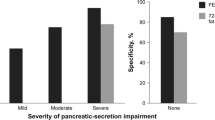Abstract
Direct pancreatic function tests have been the mainstay for the diagnosis of pancreatic exocrine insufficiency. Due to their cumbersome nature and limited availability there is a continuous search for a rapid and inexpensive test of pancreatic function. Endoscopic approaches to evaluate pancreatic function have been assessed. This article critically reviews the current evidence related to this novel approach, outlining some elements for further refinement.
Similar content being viewed by others
References and Recommended Reading
Somogyi L, Ross SO, Cintron M, et al.: Comparison of biologic porcine secretin, synthetic porcine secretin, and synthetic human secretin in pancreatic function testing. Pancreas 2003, 27:230–234.
Stevens T, Conwell DL, Zuccaro G, et al.: Electrolyte composition of endoscopically collected duodenal drainage fluid after synthetic porcine secretin stimulation in healthy subjects. Gastrointest Endosc 2004, 60:351–355.
Bornschein W: A fast endoscopic test of pancreatic secretion (endoscopic secretin-caerulein test). Zeitschrift fur Gastroenterologie 1978, 16:582–592.
Madrazo-de la Garza JA, Gotthold M, Lu RB, et al.: A new direct pancreatic function test in pediatrics. J Pediatr Gastroenterol Nutr 1991, 12:356–360.
Del Rosario MA, Fitzgerald JF, Gupta SK, et al.: Direct measurement of pancreatic enzymes after stimulation with secretin versus secretin plus cholecystokinin. J Pediatr Gastroenterol Nutr 2000, 31:28–33.
Pfefferkorn MD, Fitzgerald JF, Croffie JM, et al.: Direct measurement of pancreatic enzymes: a comparison of secretagogues. Dig Dis Sci 2002, 47:2211–2216.
Conwell DL, Zuccaro G Jr. Vargo JJ, et al.: An endoscopic pancreatic function test with synthetic porcine secretin for the evaluation of chronic abdominal pain and suspected chronic pancreatitis. Gastrointest Endosc 2003, 57:37–40. In this study the authors evaluate the bicarbonate concentration via the endoscopic secretin test in a group of patients with and without risk factors for chronic pancreatitis compared with a group of patients with chronic pancreatitis.
Ceryak S, Steinberg WM, Marks ZH, et al.: Feasibility of an endoscopic secretin test: preliminary results. Pancreas 2001, 23:216–218.
Conwell DL, Zuccaro G, Jr, Vargo JJ, et al.: An endoscopic pancreatic function test with cholecystokinin-octapeptide for the diagnosis of chronic pancreatitis. Clin Gastroenterol Hepatol 2003, 1:189–94. In this study patients were given CCK-octapeptide, and duodenal juice was subsequently collected endoscopically for up to 80 minutes. Although the test appeared to be highly sensitive, its long duration may limit its use in clinical gastroenterology practice.
Conwell DL, Zuccaro G, Morrow JB, et al.: Cholecystokinin-stimulated peak lipase concentration in duodenal drainage fluid: a new pancreatic function test. Am J Gastroenterol 2002, 97:1392–1397.
Raimondo M, Imoto M, DiMagno EP: Rapid endoscopic secretin stimulation test and discrimination of chronic pancreatitis and pancreatic cancer from disease controls. Clin Gastroenterol Hepatol 2003, 1:397–403. The authors report their experience with a rapid porcine secretin endoscopic test in 412 patients with pancreatic diseases. Although lipase concentration was significantly lower in patients with chronic pancreatitis and pancreatic cancer compared with patients with normal pancreas, the test was not accurate enough for clinical routine application (positive and negative predictive values 73% and 85%, respectively).
Maringhini A, Nelson DK, Jones JD, et al.: Is the plasma amino acid consumption test an accurate test of exocrine pancreatic insufficiency? Gastroenterology 1994, 106:488–493.
Stevens T, Conwell DL, Zuccaro G, et al.: Analysis of pancreatic elastase-1 concentrations in duodenal aspirates from healthy subjects and patients with chronic pancreatitis. Dig Dis Sci 2004, 49:1405–1411. This is a feasibility study for the analysis of pancreatic elastase in duodenal juice obtained by the endoscopic pancreatic function test in patients with chronic pancreatitis and in a control group.
Ochi K, Harada H, Mizushima T, et al.: Intraductal secretin test is as useful as duodenal secretin test in assessing exocrine pancreatic function. Dig Dis Sci 1997, 42:492–496.
Scolapio JS, Raimondo M, Woodward TA, et al.: Selenium concentrations in pancreatic juice of patients with chronic pancreatitis vs. age matched controls. JPEN 2004, 28:339–341. This study evaluates the selenium concentration in duodenal juice after secretin stimulation to discriminate patients with chronic pancreatitis from patients with normal pancreas.
Pungpapong S, Scolapio JS, Woodward TA, et al.: Is zinc concentration in pancreatic fluid a marker for pancreatic diseases? J Pancreas 2005, 6:425–430. This study evaluates the zinc concentration in duodenal juice after secretin stimulation to discriminate patients with chronic pancreatitis and pancreatic cancer from patients with normal pancreas.
Noh KW, Woodward TA, Wallace MB, et al.: IL 8 in pancreatic juice predicts the presence of pancreatic diseases. Gastroenterology 2005, 128:A472.
Conwell DL, Zuccaro G, Purich E, et al.: The effect of moderate sedation on exocrine pancreas function in normal healthy subjects. A prospective, randomized, cross-over trial using the synthetic porcine secretin stimulated endoscopic pancreatic function test (ePFT). Am J Gastroenterol 2005, 100:1161–1166.
Saunders JHB, Masoero G, Wormsley KG: Effect of diazepam and hyoscine butylbromide on response to secretin and cholecystokinin-pancreozymin in man. Gut 1976, 17:351–353.
Louie DS, Chen HT, Owyang C: Inhibition of exocrine pancreatic secretion by opiates is mediated by suppression of cholinergic transmission: characterization of receptor subtypes. J Pharmacol Exp Ther 1988, 246:132–136.
Gullo L, Priori P, Costa PL, et al.: Effects of morphine on human pancreatic secretion: studies on pure pancreatic juice. Gut 1982, 23:739–743.
Odes HS, Bank S, Barbezat GO, et al.: The effect of diazepam on human pancreatic secretion. S Afr Med J 1976, 50:1141–1143.
Author information
Authors and Affiliations
Corresponding author
Rights and permissions
About this article
Cite this article
Pungpapong, S., Raimondo, M. Endoscopy-based pancreatic function tests. Curr Gastroenterol Rep 8, 127–131 (2006). https://doi.org/10.1007/s11894-006-0008-6
Issue Date:
DOI: https://doi.org/10.1007/s11894-006-0008-6




